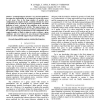1446 search results - page 164 / 290 » Formal analysis of hardware requirements |
UML
2005
Springer
14 years 3 months ago
2005
Springer
Use cases are a popular method for capturing and structuring software requirements. The informality of use cases is both a blessing and a curse. It enables easy application and lea...
SACMAT
2009
ACM
14 years 4 months ago
2009
ACM
Traditional access control models, such as Role-Based Access Control (RBAC), do not take into account contextual information, such as location and time, for making access decision...
ECBS
2009
IEEE
14 years 5 months ago
2009
IEEE
In response to changing requirements and other environmental influences, software systems are increasingly developed incrementally. Successful implementation of new features in e...
DATE
2009
IEEE
14 years 5 months ago
2009
IEEE
— Fault injection has become a very classical method to determine the dependability of an integrated system with respect to soft errors. Due to the huge number of possible error ...
DATE
2009
IEEE
14 years 5 months ago
2009
IEEE
—Today verification, testing and debugging of SystemC models can be applied at an early stage in the design process. To support these techniques gaining required information of ...

